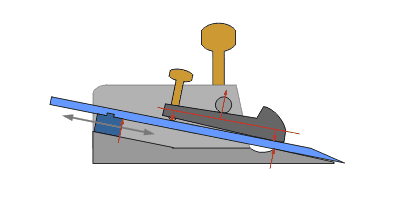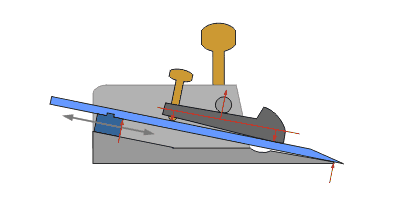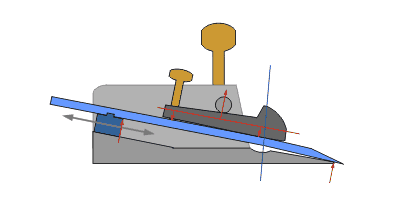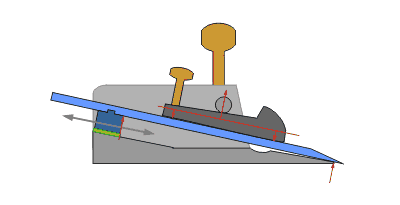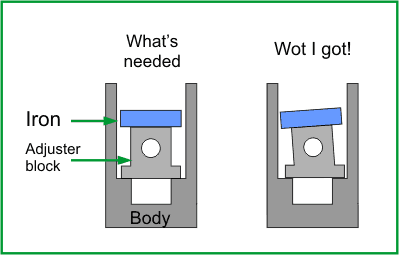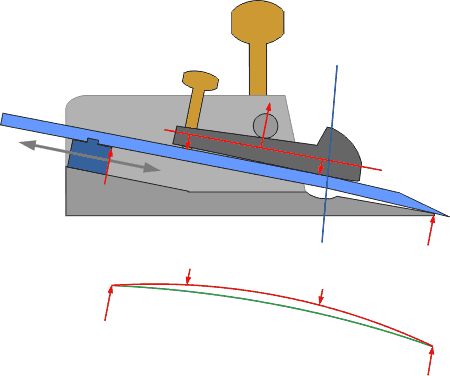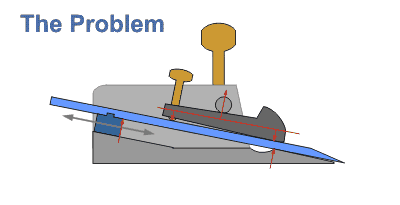Right! Sorted an animation out (at the end of this post), so that you can easily see the differences in the setup. The images change after about 10 secs and it cycles, so you'll see the images in order, eventually.
. . .
The red arrows show where the points of contact are, and the red line is to help give an idea of the forces on the blade. I've tried to get the dimensions in proportion to the real thing as much as possible. I've omitted the adjuster screw and its anchor point for clarity, also the other notches in the blade. The nose contributes nothing to this issue, so I couldn't be bothered to draw it!
The problem: you can see (I hope!) that the blade is only supported at the back of the frog. This means it can vibrate (chatter) at the front when cutting, like a clarinet reed. The effect is roughness and possibly digging in. It's partly because the cap iron can't apply pressure in the right place, because of the long front bevel. you can see too that tightening the cap iron screw makes matters worse, by causing it to bend downwards in the middle, lifting the cutting edge further.
Fix #1 is to re-grind the frog to a lower angle. This closes up the gap under the iron. It doesn't help the cap screw issue though.
Fix #2 is to bend the plane iron, just behind where the cap iron bears on it. The blue line in the diagram shows the point of the bend. This makes a rough arch (see below), and although the cap iron will flatten it, the blade now pivots on the front of the frog, and doesn't open up a gap.
Fix #3 is Andy T's idea, to put a shim under the adjuster block. This will also help hugely, as it tips the iron forwards and moves the contact point to the front of the mouth. I'm going to try this today, as it's very quick to do, reversible, and doesn't damage anything if I mess it up!
The other reason I like Andy T's idea is I've been forced to thin the adjuster block already, for this reason:
The frog was also out of true (wedge-shaped, sideways!), and initially I couldn't understand why truing it up still left the blade projection squiffy. The adjuster block is such an easy thing to machine (it should be square and requires no odd angles at all), that it never occurred to me that they cocked this up too. It was HUGELY out of true - about 10 degrees.
Grinding it straight reduces its height, of course, so shimming is good!
And finally...
The image above shows what I mean about making an arch with an intentionally bent blade. As the cap iron pressure increases, it flattens, but the points of contact don't change (much). You can really lock down the cap iron without upsetting the geometry.
. . .
There are a couple of givens in this: that the actual angle of attack isn't critical (within, say, a couple of degrees either way), and that I can get the cap iron to behave properly.
Right now the bottom surface of the cap iron is concave at the front, which applies maximum pressure to the front of the blade, but limits the leverage and control available from the cap screw (it's not currently shaped as drawn, but the distances between pressure points are correct: it is almost an even see-saw). I think what's needed is a gentle convex curve at the front end of the cap iron. The #90 has this, and it rolls on the blade, applying good clamping force and allowing a lot of control with the cap screw.
Do I regret buying it? A bit, if I'm honest. But I've learned a huge amount so far about steels and plane geometry, and now I am resolved to beat this thing into submission!
Can I recommend one to anyone else - I'll leave you to guess [-X





